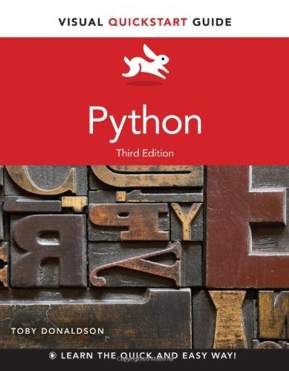| Python: Visual QuickStart Guide (3rd Ed) |
|
Author: Toby Donaldson The new edition of this beginner's introduction to Python comes with eBook access - which seems a worthwhile advantage. Toby Donaldson's Visual Quickstart Guide to Python sports a new but slightly cryptic cover but once you look inside there's isn't much change - until you hit the new final chapter more of which later. Although it has been updated where necessary and the version covered is now Python 3.3. In the real world you'll still find versions of Python 2 in use and if you need to learn about it this isn't the book you need as the differences between the two versions are subtle and confusing. However, if you have a free choice in the matter Python 3 is now the better choice.
As a Visual Quickstart Guide this book has to follow a set format - one that is characterized by a lot of white space. The layout style calls for the main text to be in the columns at the outer edge of the page with the inner two columns being reserved for illustrations a boxout with notes and asides. This results in many pages being half empty. As pointed out in at the very start, Python's creator, Guido Van Rossum named his language after the Monty Python comedy team and there is a longstanding tradition of making jokey references to this classic of the 1980's - for example the IDE being called IDLE after Eric Idle. You won't find any such humor in this book which takes a no-nonsense approach and does a workmanlike job of teaching you to progam, and to program Python in particular. It introduces the IDLE editor early in the book. This is no longer the only Python IDE but you should find it easy enough to use the book in conjunction with one of the alternatives. On the other hand, note that Python is treated as if it was a standalone language and if you plan is to use it for web development or for any specific purpose you will need another book.
On the whole the book takes a logical approach and starting from how to install Python works its way through simple arithmetic, variables, flow of control, functions, and strings.However, probably in an attempt to be comprehensive, it does sometimes introduce topics unnecessarily or in a suboptimal order. For example in Chapter 2 it states that Python supports complex numbers only to say they won't be covered and we are introduced to Booleans and conditionals before the IF statement. Advanced data structures and exception handling are both covered before introducing objects in what used to be the final chapter on Object Oriented programming. I think that this topic should have been introduced earlier in the book and that it isn't enough if you want to learn good object-oriented Python, I do welcome its inclusion as "better late than never". I also welcome the new final chapter which walks through the development of a larger Python program. Working through this - from problem description, via tackling the its separate components, to the final listing - should give Python novice's confidence to write useful programs of their own. If you are looking for a standard account of Python 3 suitable for the complete beginner this one is worth consideration.
|
|||
| Last Updated ( Wednesday, 09 October 2013 ) |

